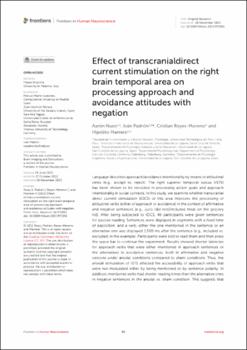Effect of transcranialdirect current stimulation on the right brain temporal area on processing approach and avoidance attitudes with negation
Fecha
2022Resumen
Language describes approach/avoidance intentionality by means of attitudinal
verbs (e.g., accept vs. reject). The right superior temporal sulcus (rSTS)
has been shown to be recruited in processing action goals and approach
intentionality in social contexts. In this study, we examine whether transcranial
direct current stimulation (tDCS) of this area improves the processing of
attitudinal verbs (either of approach or avoidance) in the context of affirmative
and negative sentences [e.g., Julio (did not)/included meat on the grocery
list]. After being subjected to tDCS, 46 participants were given sentences
for passive reading. Sentences were displayed in segments with a fixed time
of exposition, and a verb, either the one mentioned in the sentence or an
alternative one was displayed 1,500 ms after the sentence (e.g., included vs.
excluded, in the example). Participants were told to read them and then press
the space bar to continue the experiment. Results showed shorter latencies
for approach verbs that were either mentioned in approach sentences or
the alternatives in avoidance sentences, both in affirmative and negative
versions under anodal conditions compared to sham conditions. Thus, the
anodal stimulation of rSTS affected the accessibility of approach verbs that
were not modulated either by being mentioned or by sentence polarity. In
addition, mentioned verbs had shorter reading times than the alternative ones
in negative sentences in the anodal vs. sham condition. This suggests that stimulation caused an effect of negation in the activation of the mentioned
verb. Implications are discussed in the context of the role of the rSTS in
processing attitudinal verbs and negation to understand better approach and
avoidance mediated by language in the framework of the two-step model of
negation processing.





